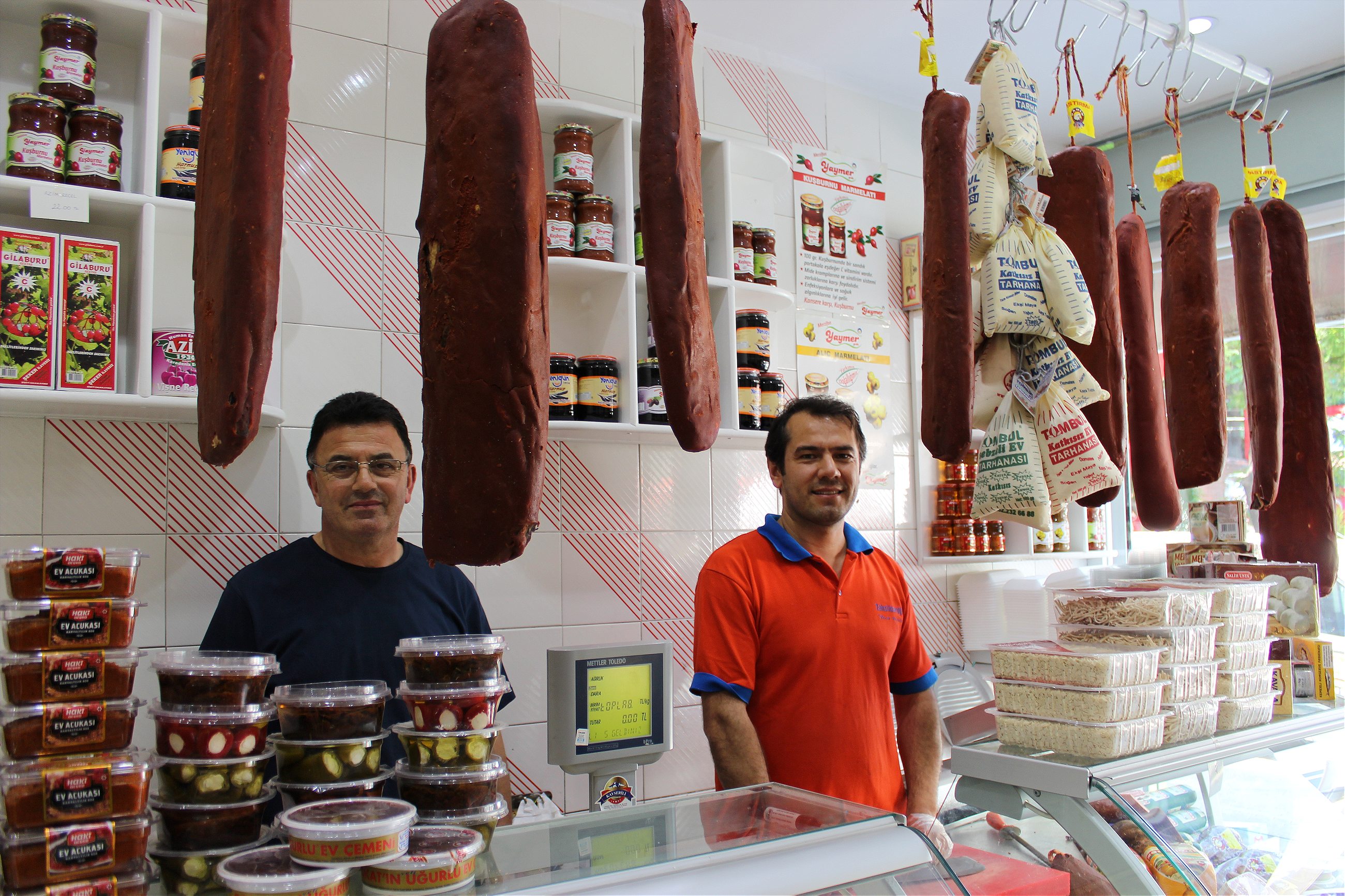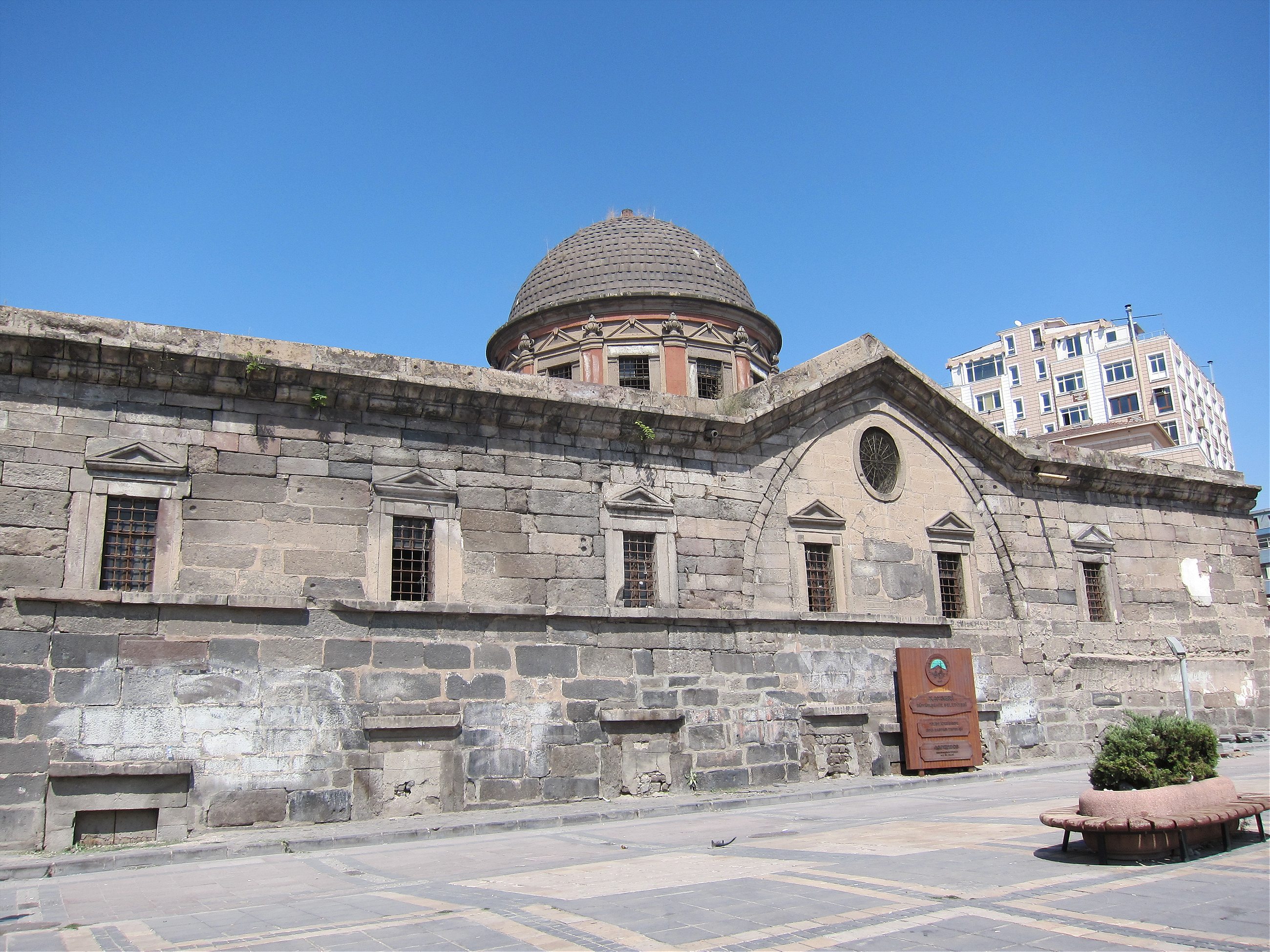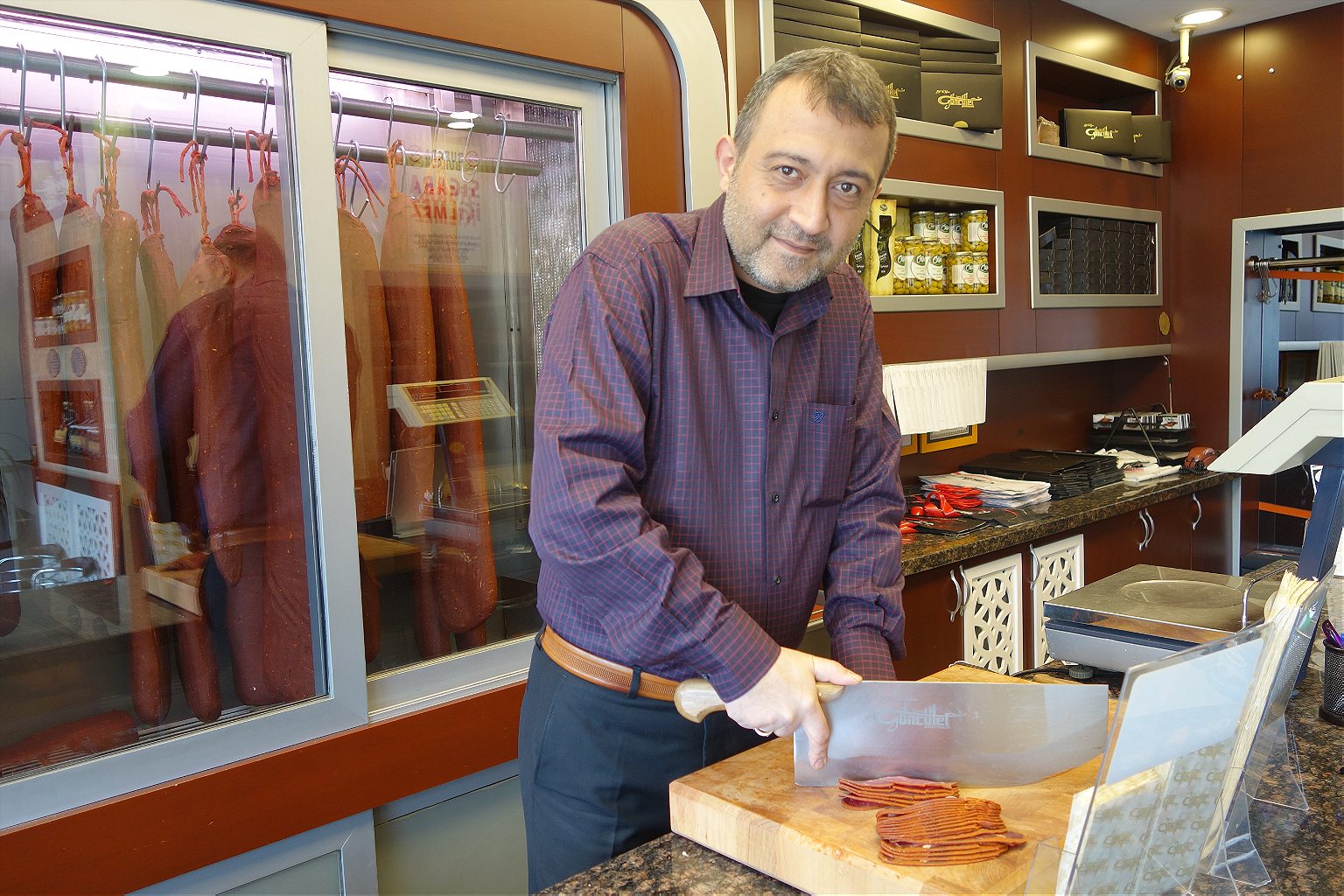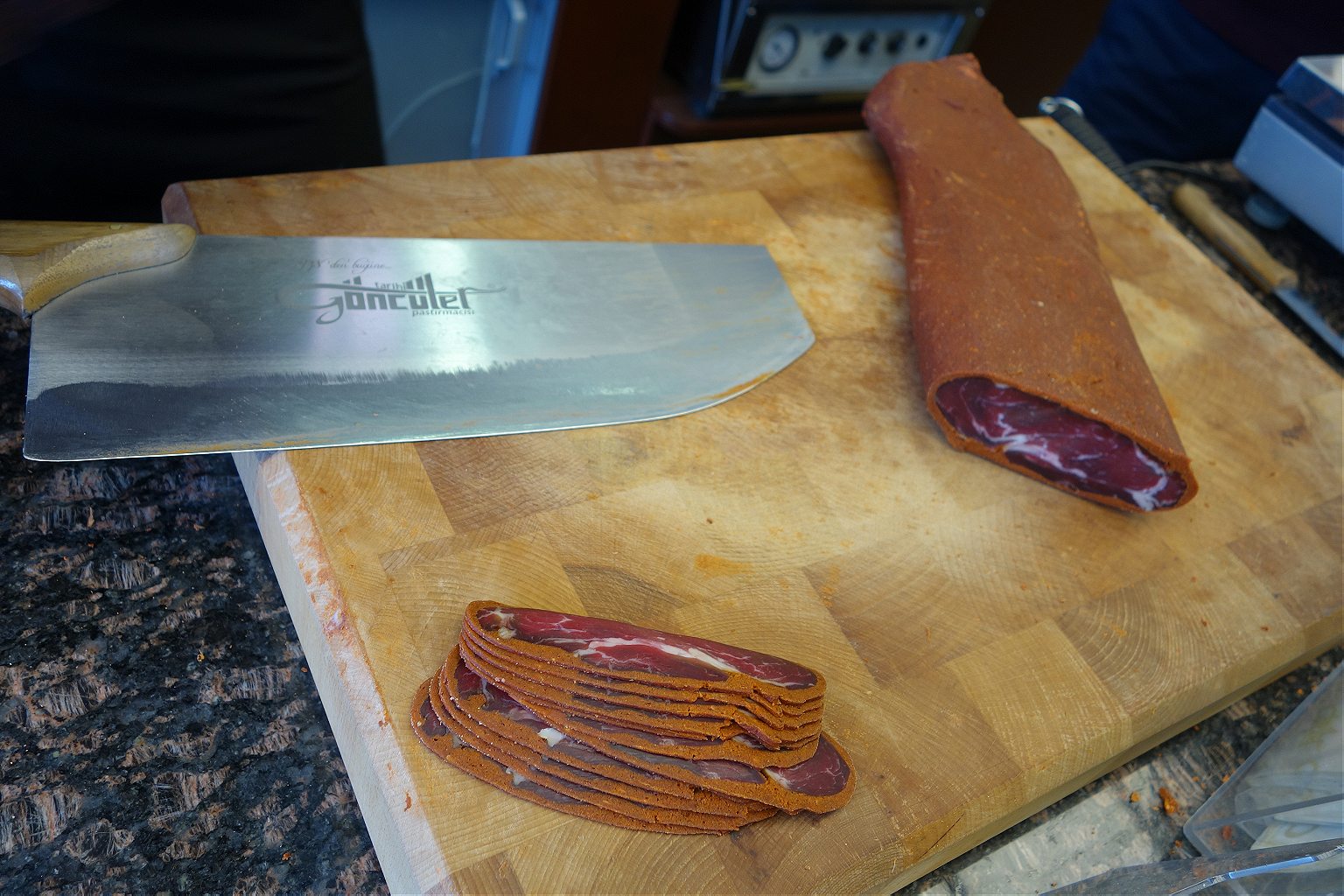Turkish pastırma is the spice-laden, lightly cured ancestor to one of New York’s great deli meats.
KAYSERI, Turkey—
I should admit that during my first year in Turkey, I was—aside from the chunks of meat that restaurants like to smuggle into innocent-looking beans—a vegetarian. Though I enjoyed the wealth of meat-free mezzes, salads, and sarma on offer, one day I asked myself, “How have I lived in Turkey for this long without eating a kebab?” And so it began.
Four years later, I remain an omnivore. But even if I do return to a shoots-and-leaves-only diet, there is one star of Turkish cuisine that will remain as an exception: the air-dried, super-spiced, garlic-infused, thinly sliced beef known as pastırma, which is synonymous with the city of Kayseri. In retrospect, I was lucky to have embraced meat before dating the Kayseri girl who is now my wife, as otherwise there would have been serious objections at the wedding.
Stepping off the plane from Istanbul at the Kayseri airport, you are met with a whiff of manure from the surrounding fields. A straight, flat road takes you to the city center in ten minutes. Apartment buildings and hotels alternate with Seljuk mosques, madrassahs, and tent-like mausolea called kümbet. There are no winding roads, no blaring horns, no grinding traffic, no bellowing crowds; oddly, this Anatolian city of one million seems more modern than Istanbul.
Above it all is the snow-capped peak of Mount Erciyes. This dormant volcano, the highest peak in Central Anatolia, is a shimmering glimpse of heaven rising from the Kayseri plain. On the other side are the surreal rockscapes of Cappadocia, produced by the erosion of volcanic matter that spewed across the region millions of years ago and beloved by tourists. On this side of the mountain, the rockless flatlands of Kayseri do not draw the same crowds. There are no balloon trips or horseback rides here, and few foreigners are drawn to the city’s Seljuk architecture, which combines the shape of Turkic tents with traces of Iranian arabesque. Instead, it is the unique conditions of heat and wind that have made Kayseri famous as the pastırma capital of Turkey.

According to Turkish tradition, this form of meat arrived in Kayseri in the 11th century, stuffed in the saddle bags of the Seljuk horsemen who carved up the withering Byzantine Empire. The Seljuks were the first wave of Turks to settle in Anatolia though their culture was strongly influenced by Iran. Writers and philosophers such as Rumi, al-Ghazali, and Sa’adi Shirazi flourished under the Seljuk Empire that ruled much of Iran, Anatolia, and the Arab world.
These Turkic warriors were by no means pastırma’s inventors, continuing a Central Asian tradition that predated Atilla the Hun. In summer, the nomadic Huns would dry a portion of their meat, saving it for the freezing winters of the steppe when food was scarce.
A rather hostile description from ancient Roman historian Ammianus Marcellinus reports that the Huns were fond of “the half-raw flesh of any kind of animal whatever, which they put between their thighs and the backs of their horses.” The word pastırma comes from a Turkic root meaning “to press,” and pressure with weights is part of the production process. But holding raw meat against a horse seems unsanitary even for a Hunnic stomach, and this detail is likely a product of the Roman imagination.
When the Seljuk Empire crumbled and the Ottoman Empire rose in its place, pastırma still held sway over the imperial palate. Mehmet II, the Ottoman sultan who conquered Istanbul in 1453, liked to break his fast during Ramadan with a dish called Yumurta-yı Hümayun or “Imperial Eggs.” Consisting of caramelized onions, eggs, and pastırma served hot in the pan, this dish was savored by generations of sultans afterwards.
Many of Istanbul’s grand palaces and mosques might owe their place to pastırma.
Two centuries later, travel writer Evliya Çelebi confirmed Kayseri as the empire’s pastırma capital in his epic the Seyahatname. After a visit to Kayseri, Çelebi writes, “…the cumin-flavored beef pastırma that is famous under the name lahm-ı kadit (thinly sliced meat) is found nowhere else. They send it as gifts to Istanbul.”
If one story about imperial architect Krikor Balyan is true, then many of Istanbul’s grand palaces and mosques owe their place to pastırma. In the 1820s, a row between political factions forced Balyan into exile in Kayseri. According to Ottoman writer Teotoros Lapçinciyan, the architect plotted his return by sending the sultan a box of finest Kayseri pastırma. The sultan was so taken with the gift that soon enough, Balyan was back in Istanbul, founding a family business that designed magnificent buildings, from Dolmabahçe Palace to Ortaköy Mosque. Unjustly, there are no plaques commemorating pastırma’s role in their construction.
Nowadays, pastırma is equally at home among cheeses and jams on the breakfast table and with mezzes and rakı in the taverns. While Istanbul consumes the most pastırma in the country, the only way to understand this meat’s special character is by visiting its natural habitat in Kayseri.
Pastırma production takes place mostly in the summer months, when the hot weather can be relied on to dry the meat. However, for the pastırma that even Kayseri locals regard as gourmet, you must wait for a mythical hot spell in November known as “pastırma summer.” The vast difference in daytime and nighttime temperatures—up to 25 degrees Fahrenheit and down to minus 5—makes the meat that much more tender.
From start to finish, the pastırma process takes around one month. The choice cuts for pastırma are from the rib, sirloin, and fillet. The fattiest parts of the rib and fillet are called tütünlük and kuşgömü, and these are the prized cuts among connoisseurs. Kayseri locals say that these cuts “make the beard dance,” because chewing on these soft morsels is just enough motion to make the hairs on your chin shake, no more.

Culinary maven Kadriye Özdemir, who also happens to be my mother-in-law, grew up in the nearby village of Karakuyu and has lived in Kayseri city for the last forty-five years. It is mostly Circassians who live in Karakuyu, having settled there after the Russians expelled them from their Caucasian homeland in the 1860s. Pastırma is not considered a part of Circassian cuisine proper, but Özdemir soaked up the recipe from her Turkish neighbors.
Özdemir and others in her generation are perhaps the last to still make pastırma at home rather than buying it from a store. The traditional method requires the meat to be hung up in the wind: according to local belief, the snow-tinged wind from Mount Erciyes imparts an indescribable flavor. Kadriye still uses the wind, while industrial producers must use ovens to meet hygiene standards. According to her, the process is as follows:
- Cover the back of the meat in a generous amount of rock salt and leave it for one day.
- With the meat still in the salt, put a weight on it to push out the fluid. Leave for one week.
- Remove the meat from the salt. Wrap the meat in moist muslin and change the muslin every day for one week. This absorbs the excess salt from the meat.
- Take the muslin off and hang the meat in a shady spot that is open to the breeze for two days.
- At this point, you should prepare the pastırma coating, called çemen. The name means fenugreek, and beside those nutty seeds the spice rub also contains garlic, red pepper, black pepper, cumin, salt, and water. Once those ingredients are kneaded into a paste, spread them over the meat to a thickness of about half a centimeter.
- Finally, hang the spiced meat in the same spot for another two days. Now it’s ready for slicing and eating.
The effects of this process are fourfold: although the meat is technically eaten raw, the salting and pressure soften and cure the meat to make it more digestible; the çemen layer seals the meat off from the air; the garlic in the çemen acts as an antimicrobial barrier; and, of course, the çemen mix of garlic and spices gives the pastırma its pungent kick. Whether as leftovers from pastırma-making or prepared separately, Kayseri families also enjoy çemen as a spread on the breakfast table.
The cruder nationalists in Turkey have a habit of forgetting the contributions of non-Turks to their cuisine (not to mention music, literature, language, and virtually everything else). Some foods unarguably originated in the Turkic areas of Central Asia, such as yogurt; the harsh conditions of the steppe forced the nomads to make something edible out of animal milk, as at that time humans had not developed the stomach enzymes to digest it.
But the case of pastırma is not so clear-cut. Turkish nationalists would point to the fact that pastırma is a Turkish word, and all other languages use a variation of it: take pastourmás in Greek, pastrámă in Romanian, basṭirma in Arabic, and, of course, pastrami in English. But that doesn’t rule out the possibility that there was already a meat similar to pastırma in Byzantine Anatolia before the Turks arrived. In fact, the Turks may have combined their own pastırma tradition with a Greek salted meat called pastón. Given the millennia of human migrations and trade routes that have passed through and around Anatolia, these attempts to attach ethnic labels to food are fairly futile.
Wherever pastırma comes from, we know that the once-numerous Armenian population of Kayseri had cornered the business by the 19th century. Historian Philip Mansel notes that Armenians fleeing rebellions and wars in Anatolia arrived in Istanbul from the 17th century onwards, some of them selling pastırma on the streets. One frank saying from Kayseri testifies to the Armenian mastery of this art with the words, “A shaky Muslim will leave his religion for the Armenian’s pastırma.”
During the genocide of 1915, reality turned this saying around: it was the Armenians who became Muslims. Official correspondence indicates that over 6,000 Kayseri Armenians converted to Islam to keep their homes and lives. So besides the tiny number of people who have kept their Armenian names and religion in Kayseri, there are likely many more with hidden Armenian roots. One Armenian pastırma dynasty that lives on today is the Apikoğlu brand, founded in Kayseri by Krikor Apikoğlu in 1910. Moving its production to Istanbul in 1920, Apikoğlu became the first nationwide meat company of the Turkish Republic.

Kayseri is still home to the Central Anatolia region’s only active Armenian church, located in the Talas district, a short distance from the city center. Close to Kayseri castle is another Armenian landmark, the church of Surp Asdvadzadzin, or Mother Mary. The municipality began restoration on this building, which had been used as sports center for around forty years, in 2013. Local sensitivities came to the fore when the municipality hung a banner reading “Church of Mother Mary Restoration Project.” The perceived implication that the building would be reopened for Christian worship created a storm in the local media, and the sign changed to “Project to Convert Mother Mary Church into a Culture and Arts Center.” As of 2017, the church is still inaccessible due to ongoing work. Though much of the once-thriving Armenian culture in the region has been erased, the Armenian soul still suffuses the city through spicy wafts of pastırma.
When in Kayseri, those in the know go to Tarihi Göncüler Pastırmacısı. This producer has passed through three generations of the Küçükgöncü family since its foundation in 1938. They take telephone orders from across Turkey, but part of the pleasure is visiting the shop, choosing from among the dangling slabs of çemen-coated beef, and watching the master, İbrahim Küçükgöncü, wield his whopping cleaver. It is an unspoken rule of pastırma that it must be sliced by hand; you will not find a shop that uses a machine. If Kayseri isn’t en route, this pastırma is also available at the Kayserili Pastırmacı shop in Bakırköy, Istanbul. The Kayseri-Armenian-pastırma triangle is in evidence here as well, as the neighborhood has an active Armenian church that serves many families with roots in Kayseri.


Being a relatively expensive meat with a powerful flavor, pastırma has a slim but punchy place on the mezze table. Any Istanbul tavern worth its name serves warm paçanga böreği, a crispy fried roll of filo pastry, kaşar cheese, and pastırma. The name paçanga likely has a Spanish root, as this dish is associated with the Sephardic community in Istanbul. Oven-baked pastırma also tops off tavern-style hummus, brought out in the clay dish with a slick of pastırma oil in the middle. The basement watering hole Çukur Meyhane is an Istanbul favorite for washing down such delights with plenty of potent rakı.
After trekking across Central Asia and Anatolia to Istanbul, it might seem that pastırma would have run out of juice. But it has spread much farther. Pastırma was a feature of Ottoman cuisine that took root in Eastern Europe. It then traveled with Jewish immigrants across Europe to America, adapted from the Yiddish and Romanian words into what we call pastrami, its Turkish roots mostly lost to history.
Even if we put our national pride aside for a moment, there are good reasons to differentiate between pastrami and pastırma: while pastrami is smoked and steamed, pastırma is not exposed to direct heat by cooking, and while pastrami is juicy and mellow, pastırma is a succulent spice explosion. It would be folly to rank one above the other—despite my nuptial ties to Kayseri—but at the least we should introduce the delis of New York to their long-lost relatives in Anatolia, turning pastırma’s epic journey into a loop of appreciation.